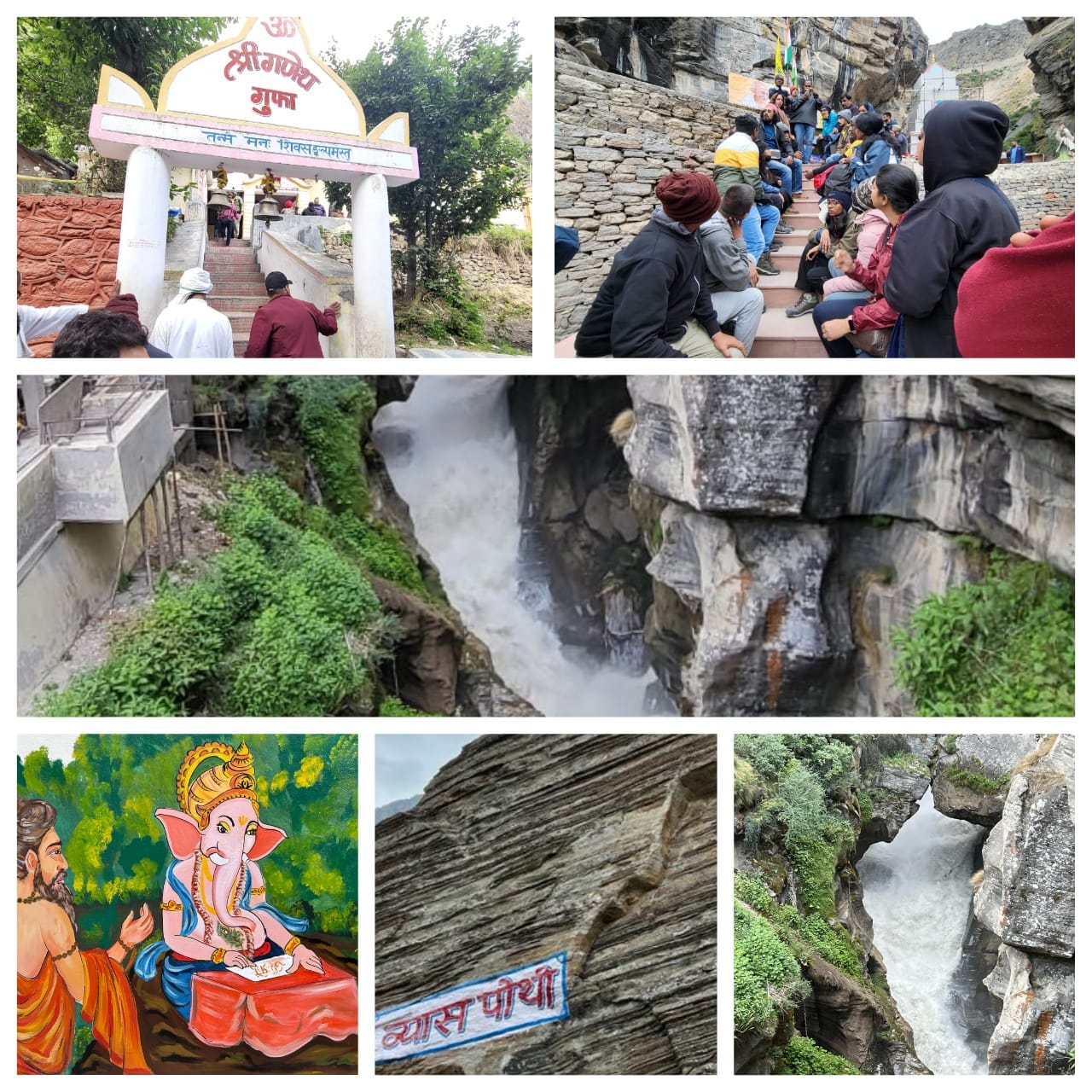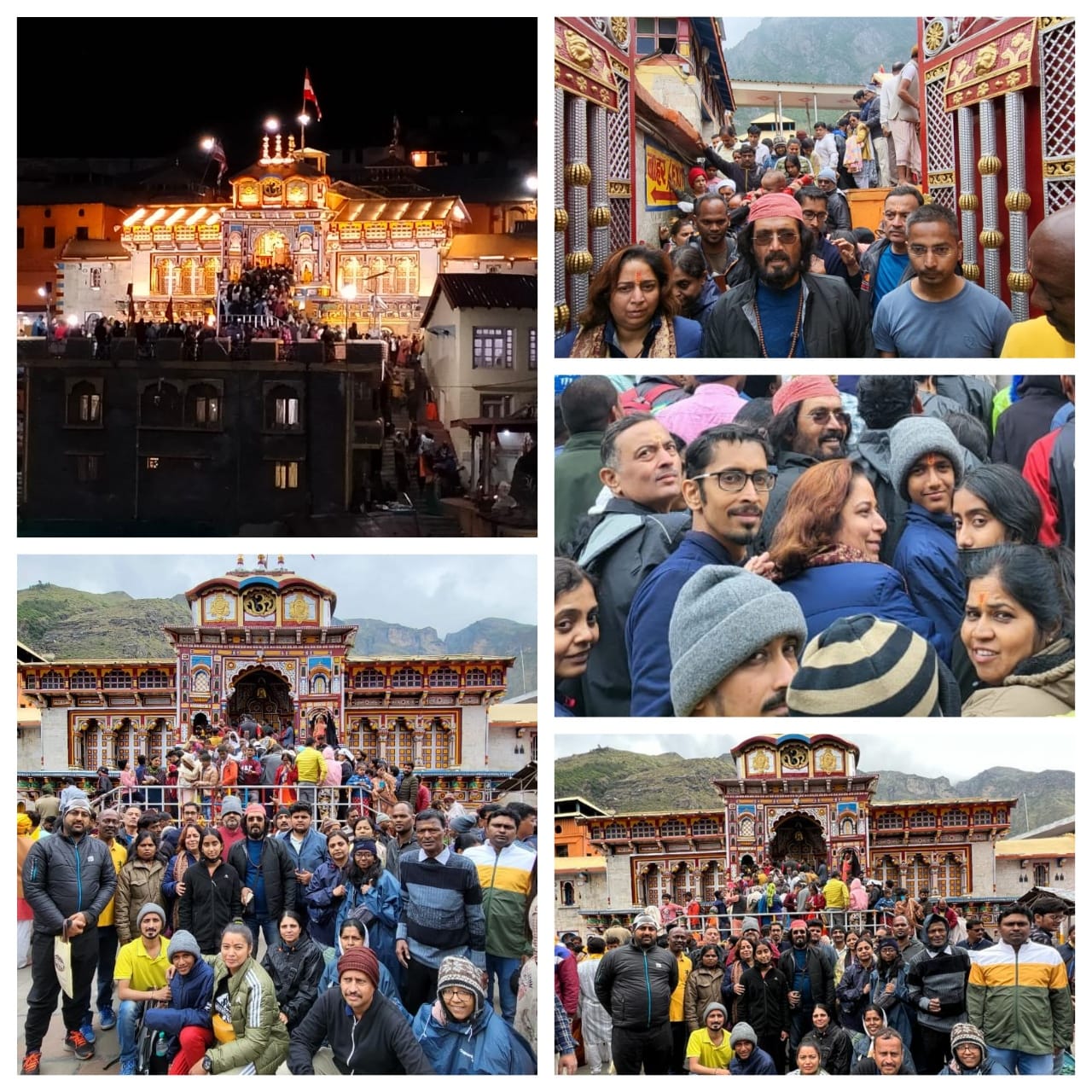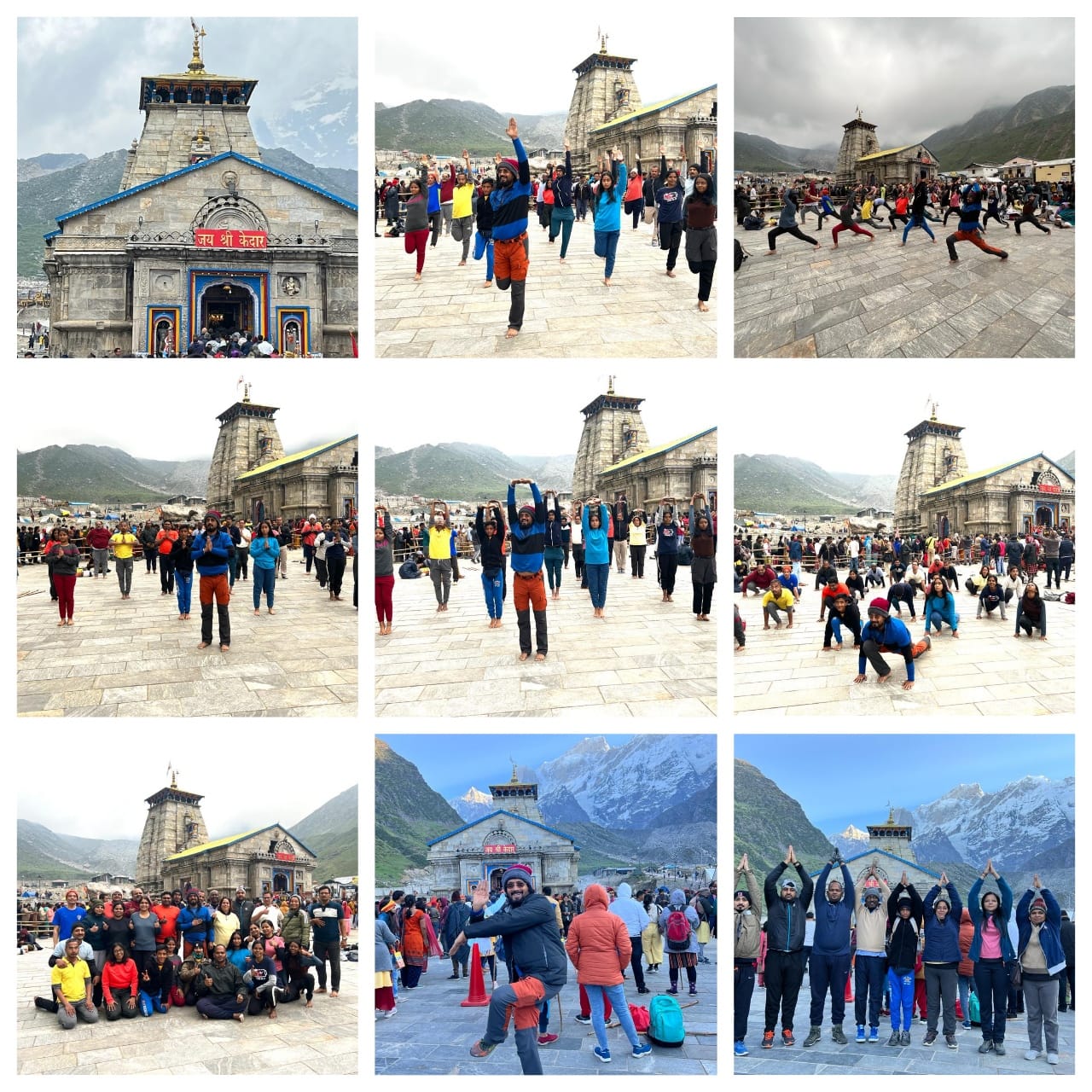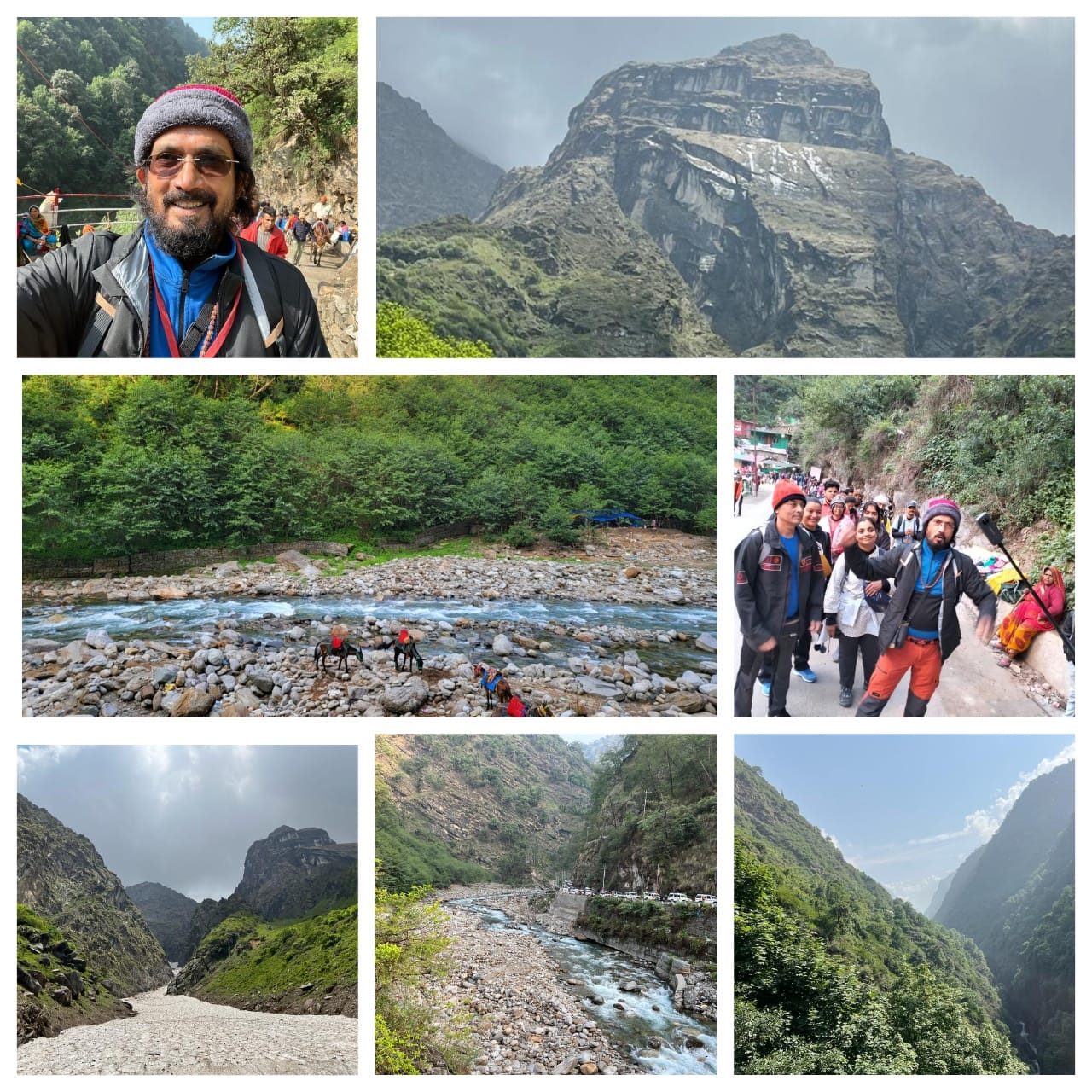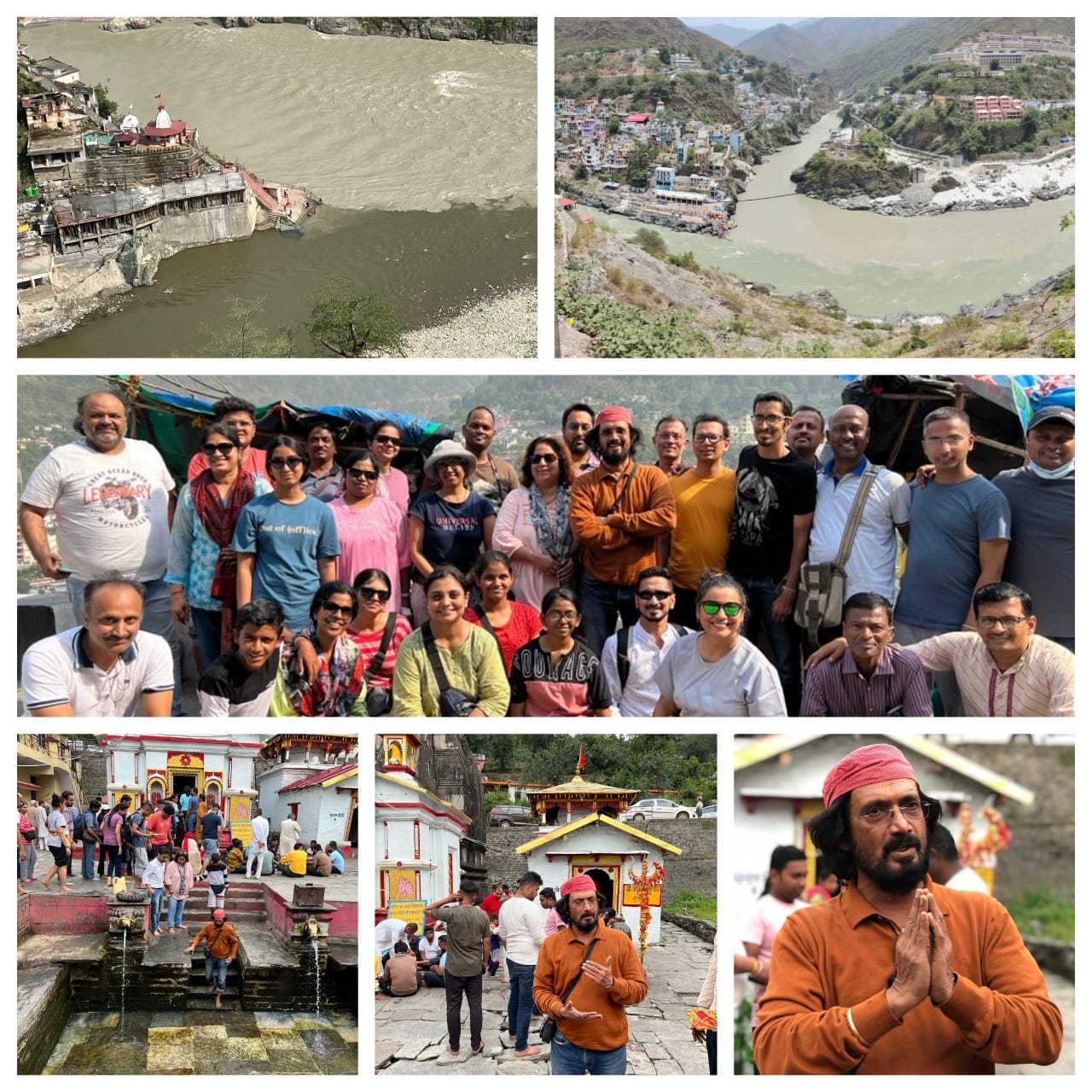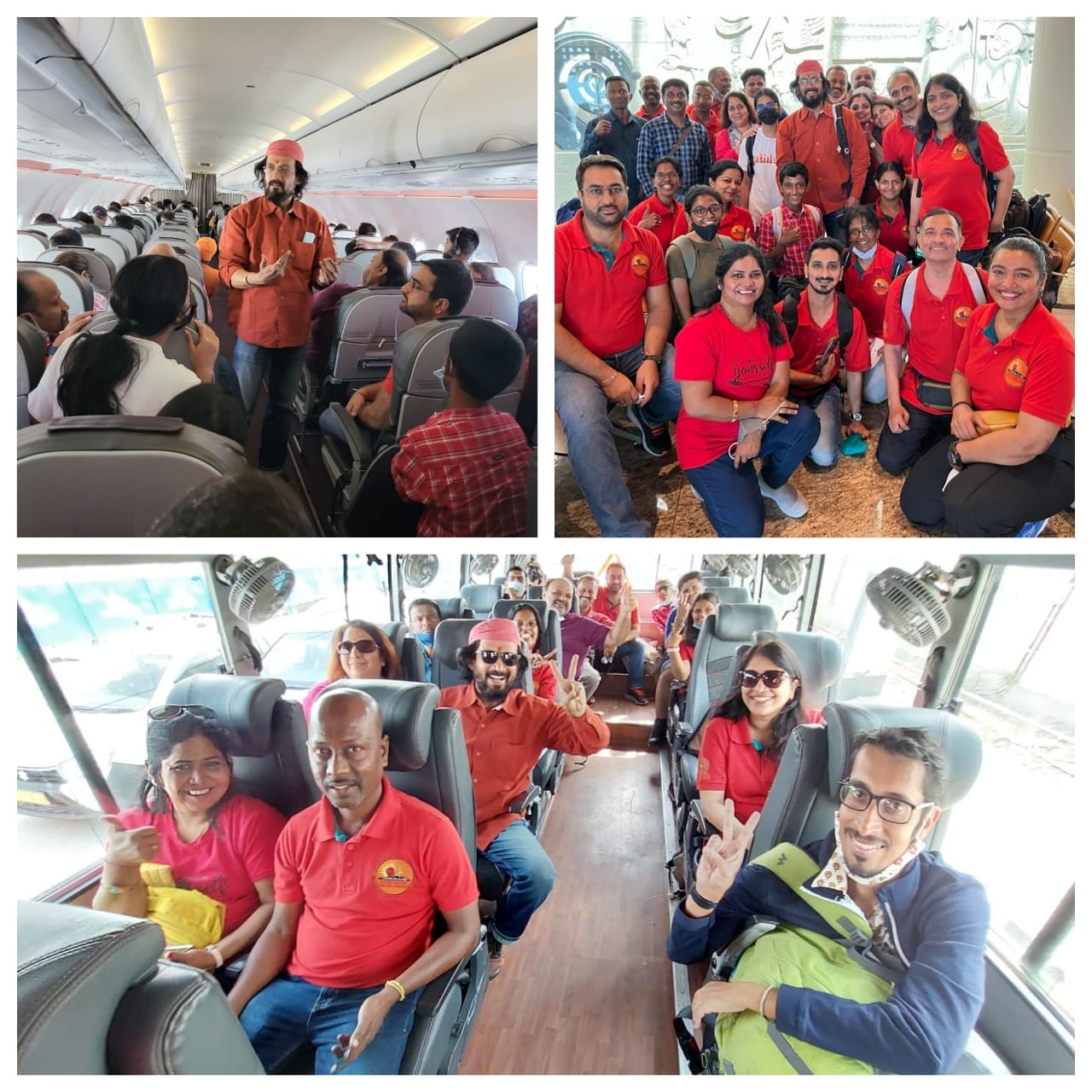Badri Kedar Yatra
Badrinath-Kedarnath Expedition by HH Sadguru Yogiraj Dr. Mangeshda
On 12th June 2022, Sadguru Yogiraj Dr. Mangeshda led a team of thirty disciples on the Do Dham Yatra to Badrinath-Kedarnath. This was His fifteenth visit to these sacred pilgrimage centres. The disciples hailing from varied parts of India landed at Dehradun airport in the afternoon and proceeded to Haridwar for the Ganga Aarti in the evening at Hari ki Pauri ghat. Our Kriyabans made their way through lakhs of spiritual enthusiasts thronging for this daily event and finally settled down at the ghat in anticipation of this daily evening ritual. At 7pm the Aarti started with beautifully lit diyas and the whole atmosphere reverberating with the chanting of ॐ जय गंगे माता. With mantras being chanted by the pundits, the environment was electric and everybody prayed for world peace and keeping the environment clean. Once done, they proceeded to their accommodation for the night.
The morning of 13th June, these Kriyabans took an early start to Sonprayag after a wholesome breakfast. On the way, they visited Devprayag. The Panch Prayag of Uttarakhand traces the route carved by Alaknanda River when it leaves its Himalayan abode from Satopanth glacier. Devaprayag is the holiest of all the Panch Prayag and is situated at the confluence of Alaknanda and Bhagirathi rivers known as Sangam. It is believed that a dip at the confluence cleanses the heart, mind and soul of a person and inches him closer to liberation or ‘Mukti’. Their next stop was at Rudraprayag which is the confluence between Alaknanda and Mandakini River. The famed town of Rudraprayag is named after the Rudra avatar of Lord Shiva. This heavenly town is encircled by the emerald lakes, glaciers, foaming rivers and silver streams. It is perched at an average elevation of 2,936 feet above sea level.
Moving on, they proceeded to Sri Kashi Vishwanath temple, one of the oldest and most sacred of temples in Uttarkashi situated on bank of river Bhagirathi. The temple offers the spectacular view of river Bhagirathi along with the surrounding mountains. The Kashi Vishwanath temple is dedicated to Lord Shiva and it is believed that he proposed to Goddess Parvati there. Within the courtyard of the Vishwanath temple and to the front of it is the Shakti Temple, dedicated to the Goddess of strength. The massive brass trident projecting from this temple bears an inscription describing how the Vishwanath Temple was built. Sadguru Yogiraj Dr. Mangeshda shared so many unknown facts and stories due to his extensive knowledge from his previous trips to this area. He and his disciples took darshan and blessings here before progressing on to the main mission of their expedition the next day.
The rising sun of 14th June saw the Kriyabans trudging upto Gaurikund to start their upward journey to Kedarnath Temple. Kedarnath is one of the sacred pilgrimage centre in Northern India, located on the bank of Mandakini river at an altitude of 3584 meters above sea level. Surrounded by beautiful snow-capped mountains Shri Kedarnath is the eleventh Jyotirlinga of the twelve Jyotirlinga of India was established by Aadi Guru Shankaracharya. Successfully reaching the top, they took darshan of Lord Shiva and marvelled at the ancient temple and its exquisite architecture. As Sadguru Yogiraj Dr Mangeshda explained this temple is built of extremely large but evenly shaped grey stone slabs. A conical rock formation inside the temple is worshipped as Lord Shiva in his “Sadashiva” form. The most thrilling part of the expedition followed when Sadguru Yogiraj Dr Mangeshda and His thirty disciples performed yoga at Shri Kedarnath Temple in front of Mahadev (the one who invented yoga-sutra) on the pious full moon day of ‘Vata Poornima.’ This was on the occasion of International Day of Yoga.
The next day i.e 15th June, they started their descent to Sonprayag from where their journey to Badrinath will continue.
After the moving darshan of Shri Kedar Baba, HH Sadguru Yogiraj Dr. Mangeshda started the descent back to Sonprayag with the rest of the Kriyabans early morning on 15th June after a hearty breakfast. Climbing down the steep slopes of the Garhwal Himalayan range, witnessing the beauty of snow peaked mountains and the Mandakini river gurgling down the rocky precipices was a treat to the senses. The team reached Sonprayag in the afternoon and immediately left for Birahi which is approximately 100km from Sonprayag where they would stay for the night.
On the way, HH Sadguru Yogiraj Dr. Mangeshda explained the significance of Panch Kedar. Out of all the temples dedicated to Lord Shiva, the cluster of five shrines of Shiva is the most revered. They are known as Panch Kedar. According to Mahabharata, when Pandavas were searching for Lord Shiva, he turned himself into a bull to avoid detection. However, when Bheema tried to capture the bull, it disappeared and later reappeared in body parts at five locations, presently known as Panch Kedar.
The hump reappeared at Kedarnath, the arms appeared in Tungnath, the navel appeared in MadMaheshwar, the face showed up at Rudranath and the hair and head appearing in Kalpeshwar. The Pandavs built temples at these five places for worshiping Shiva. Apart from this well-known mythogical tale, He also explained in detail the spiritual significance of Panch Kedar related to the five basic elements — panchamahabhutas — the properties of earth (prithvi), water (jala), fire (agni), wind (vayu) and ether (akasha).
On 16th June, the Kriyabans left Birahi for Badrinath Temple. Badrinath is located at an elevation of around 3,200 m, in the Garhwal Himalayas, on the banks of the Alaknanda river, this sacred town lies between Nar and Narayana mountain ranges. The temple is believed to have been established by sage Adi Shankaracharya in the 8th century. With Lord Vishnu as its presiding deity, the temple remains open for six months in a year.
Badrinath being one of the most legendary Temples, it has numerous mythical tales associated with it. One such tale is of the two sons of Dharma - Nar and Narayana who wished to setup their hermitage and expand their religious base amidst the pious Himalayas. Going by the legends, during their quest to find a suitable place for their hermitage they led to a chanced discovery of the four sites of Panch Badri - namely Dhyan Badri, Yog Badri , Bridha Badri and Bhavishya Badri. Finally they came across a spot which was blessed with two fascinating cold and hot springs behind river Alaknanda. They were extremely overjoyed on finding this place and thus they named this place as ‘Badri Vishal’, this is how Badrinath came into being.
After a soulful darshan of ‘Badri Vishal’, HH Sadguru Yogiraj Dr. Mangeshda led the Kriyabans to the last Indian village Mana on the Tibet/China border at a height of 3219m.
Along the path itself, they found themselves covered in between the rugged mountains, the floating white clouds, the tiny flowers greeting them with their beautiful colors, the mysterious caves and the gorgeous Alaknanda and Saraswati rivers flowing in a way as if singing for their safe journey. Here they visited the Ganesh Gufa where Lord Ganesha penned the Mahabharata as dictated by Rishi Ved Vyas. And then trudged up to Vyas Gufa where the majestic sage lived while composing the four vedas. A distinct feature of this temple is the roof which resembles the pages of Ved Vyas collection of Holy books. Finally crossing the Bheem Pul to witness the magical and mystical River Saraswati Ugam - here no one has been able to determine from where the divine river disappears under the Bheem Pul.
The Kriyabans sat at this scenic location and enjoyed chai at the last Indian Village while HH Sadguru Yogiraj Dr. Mangeshda narrated his own experiences of staying in one of the mystical caves just above Saraswati Ugam for almost a decade under the tutelage of His ParamGuru - Sri Sri Mahavtar Babaji. He disclosed secrets that are not generally known facts and personal stories while the Kriyabans listened with rapt attention. Once back to the hotel He blessed them with his Aashirvachan followed by an evening of melodious Bhakti bhajans.
The next morning on 17th June, the team left for Rishikesh, best known as the ‘Yoga Capital of India’. It would be a long arduous journey of 300km/9hrs. Enroute they visited the holy sangams of Karnaprayag, Nandapryag and Vishnuprayag. The Panch Prayag of Uttarakhand traces the route carved by Alaknanda River when it leaves its Himalayan Abode from Satopanth glacier. It is joined by Dhauliganga river at Joshimath. Nandaprayag is the second confluence in cascading sequence, where Alaknanda River is joined by Nandakini River. The third confluence of Alaknanda River is at Karnaprayag, where the tragic hero of Mahabharata, Karna, did penance to please Sun God. Here, Pindar River joins Alaknanda.
The Kriyabans reached Rishikesh late at night; the next day i.e 18th June they visited the Ram Jhoola & Laxman Jhoola. A few of them shopped for Rudraksha Malas, shankh and antique pieces made of brass. They then proceeded on their journey to Delhi, where they would take a late flight back to their respective locations spread all across India.
Kudos to a successful Do-Dham Yatra which would not have been possible without the skilled leadership, sound acumen and spiritual guidance of HH Sadguru Yogiraj Dr. Mangeshda who Himself has visited these pious Panch Kedars, Panch Badri and Panch Prayags for 15 times and having stayed in these regions for almost a decade during His Kriya Yoga Sadhana.
Jai Gurudev!


